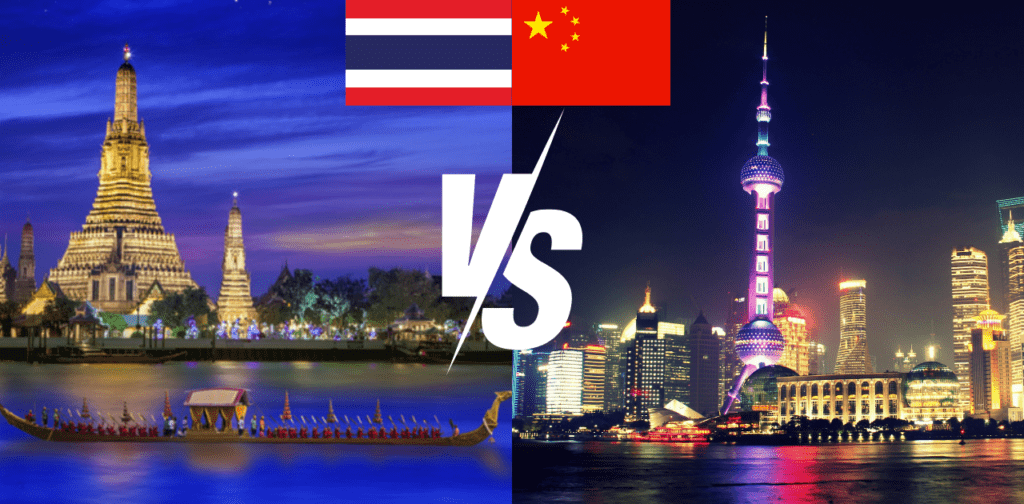Thailand vs China, two prominent Asian nations, boast rich histories, diverse cultures, and burgeoning economies. While both countries are significant players in the global arena, they differ vastly in various aspects, including cultural traditions, economic structures, and geopolitical strategies. This article delves into the multifaceted comparison between Thailand and China, highlighting their unique characteristics, challenges, and opportunities.


Cultural Contrasts:
Thailand vs China are distinguished by their cultural heritage, traditions, and societal norms. Thailand, known as the “Land of Smiles,” exudes warmth, hospitality, and a laid-back lifestyle deeply rooted in Theravada Buddhism. In contrast, China, with its ancient civilization spanning over 5,000 years, boasts a rich tapestry of Confucianism, Taoism, and Buddhism, influencing its social fabric, customs, and values. While Thai culture emphasizes harmony, respect for elders, and the concept of “Sanuk” (fun), Chinese culture prioritizes filial piety, collective harmony, and the pursuit of education and success.
Economic Perspectives:
Economically, China stands as the world’s second-largest economy, renowned for its rapid industrialization, export-driven growth, and technological prowess. With a population exceeding 1.4 billion, China’s market potential and manufacturing capabilities are unparalleled. In contrast, Thailand, while smaller in scale, boasts a dynamic economy driven by tourism, agriculture, manufacturing, and a growing services sector. The “Land of Smiles” attracts millions of tourists annually to its pristine beaches, vibrant cities, and cultural landmarks, contributing significantly to its GDP. However, Thailand faces challenges such as income inequality, political instability, and dependence on exports.
Trade and Investment Dynamics:
The trade relationship between Thailand and China has strengthened over the years, with bilateral trade volumes reaching billions of dollars. China serves as Thailand’s largest trading partner, with exports ranging from agricultural products and electronics to automobiles and machinery. Conversely, Thailand imports a plethora of Chinese goods, including electronics, textiles, and industrial machinery. Moreover, China’s Belt and Road Initiative (BRI) has catalyzed infrastructure development in Thailand, fostering connectivity and trade linkages between the two nations. However, concerns linger regarding unequal trade balances, intellectual property rights, and environmental sustainability.
Geopolitical Considerations:
Geopolitically, Thailand vs China navigates complex regional dynamics shaped by historical legacies, territorial disputes, and strategic alliances. China’s assertive foreign policy, particularly in the South China Sea, has raised concerns among neighboring countries, including Thailand, which seeks to maintain a delicate balance between Beijing and Washington. Thailand, a key ally of the United States, participates in military exercises and security partnerships while engaging in diplomatic dialogues with China to safeguard its national interests. Additionally, Thailand’s membership in regional organizations such as ASEAN (Association of Southeast Asian Nations) facilitates multilateral cooperation and conflict resolution mechanisms.
Tourism and Cultural Exchange:
Tourism serves as a vital bridge between Thailand vs China, fostering cultural exchange, people-to-people ties, and economic cooperation. Millions of Chinese tourists flock to Thailand annually, drawn by its exotic allure, culinary delights, and hospitality. Conversely, Thai cultural performances, cuisine, and handicrafts captivate Chinese tourists, fueling demand for travel packages and experiential tourism. However, the COVID-19 pandemic has disrupted international travel and tourism, challenging both countries to adapt to new health protocols, digital technologies, and sustainable tourism practices.
Future Prospects and Challenges:
Looking ahead, Thailand vs China confronts a myriad of opportunities and challenges in the realms of economic development, social progress, and environmental sustainability. Thailand seeks to diversify its economy, enhance digital infrastructure, and promote innovation and entrepreneurship to mitigate vulnerabilities and achieve sustainable growth. Meanwhile, China endeavors to rebalance its economy, promote consumption-led growth, and address environmental degradation and climate change. Collaborative initiatives such as the Regional Comprehensive Economic Partnership (RCEP) offer avenues for deeper economic integration and cooperation between Thailand, China, and neighboring countries.
Some more information about Thailand vs China
Cultural Richness:
China: With its ancient history, dynasties, and diverse ethnic groups, China boasts a rich cultural heritage. From the Great Wall to the Terracotta Army, there’s no shortage of historical wonders.
Thailand: Known for its vibrant festivals, intricate temples (such as Wat Arun and Wat Phra Kaew), and delicious street food, Thailand’s culture is equally captivating.
Food and Cuisine:
China: The variety of Chinese cuisine is mind-boggling. From Peking duck to dim sum, each region has its culinary specialties.
Thailand: Thai food is a symphony of flavors—spicy, sweet, sour, and salty. Pad Thai, green curry, and mango sticky rice are must-try dishes.
Language and Communication:
China: Mandarin (Putonghua) is the official language. Learning basic Mandarin phrases is essential for daily life.
Thailand: Thai is the official language. While English is widely spoken in tourist areas, knowing a few Thai phrases enhances the experience.
Natural Beauty: Thailand vs China
China: The landscapes are diverse—majestic mountains (like Huangshan), serene lakes (such as West Lake), and picturesque rice terraces (like Longji).
Thailand: Pristine beaches (Phuket, Krabi), lush jungles (Khao Sok National Park), and limestone cliffs (Railay Beach) make Thailand a paradise for nature lovers.
Cost of Living: Thailand vs China
China: Major cities like Beijing and Shanghai can be expensive, but smaller cities offer a more affordable lifestyle.
Thailand: Generally, Thailand is more budget-friendly. Accommodations, food, and transportation are reasonably priced.
Healthcare and Safety:
China: Healthcare infrastructure is improving, especially in urban areas. Safety is generally good, but traffic can be chaotic.
Thailand: Medical tourism is popular due to quality healthcare at lower costs. Thailand is considered safe for travelers.
Visa and Residency:
China: Obtaining a work visa can be bureaucratic, but it’s manageable. Residency permits are tied to employment.
Thailand: Tourist visas are easy to obtain, but long-term residency requires meeting specific criteria.
Conclusion: Thailand vs China
In conclusion, the comparison between Thailand and China underscores their unique cultural identities, economic trajectories, and geopolitical dynamics. While Thailand exudes warmth, hospitality, and cultural vibrancy, China embodies resilience, innovation, and economic prowess on a global scale. Despite their differences, both nations share a rich tapestry of historical ties, economic interdependence, and mutual respect. By embracing diversity, fostering dialogue, and forging strategic partnerships, Thailand and China can chart a path toward shared prosperity, stability, and harmony in the Asia-Pacific region and beyond.




